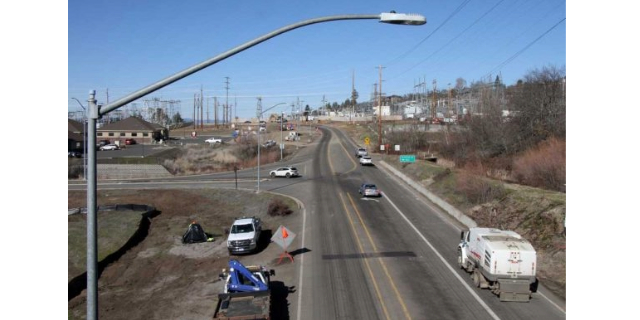GARDEN PLOTS: Planting right trees increases garden resiliency against climate change
Published 7:00 am Wednesday, February 14, 2024

- Small and medium-sized trees can provide important afternoon shade for climate-resilient gardens. Red maples like this one in the author’s yard are among the trees that are said to be heat tolerant.
“[T]rees are an important feature of the climate change garden also, providing essential shade in summer and valuable shelter from wind, slowing water, and reducing stormwater runoff.”
Trending
— Sally Morgan and Kim Stoddart, “The Climate Change Garden: Down to Earth Advice for Growing a Resilient Garden,” 2023
When Jerry and I moved to Medford 15 years ago, we wanted to put some raised vegetable beds in our backyard. One day, a crew hired by the utility company came by and told us they were going to cut several branches off an old hawthorn tree that were growing into the power lines, so we decided to have the entire tree cut down to provide more sunlight for the garden.
It was a big mistake. Not only had the hawthorn tree provided needed shade from scorching, late-afternoon heat in the summertime, but it had also supported several kinds of wildlife including birds, butterflies, bees and other beneficial insects. Our property slopes down from street level, and I realized after a few downpours (too late!) that the tree had also helped to reduce stormwater runoff.
Trending
Back then, I wasn’t aware of the importance of trees to help mitigate climate change, but I’m better informed these days. According to the Arbor Day Foundation, a mature hardwood tree absorbs about 48 pounds of CO2 every year. If that hawthorn tree was 40 years old, it would have stored about one ton of C02 in its trunk, branches, leaves and roots over its lifetime.
In fact, trees sequester about 30 to 45% of the carbon dioxide emitted by human activities every year. Yet according to the U.S. Department of Agriculture, tree cover in urban/residential areas of the U.S. is declining at a rate of approximately 36 million trees per year. Not only does this reduce the opportunity for trees to serve as a carbon sink to offset human-caused CO2 emissions, but the USDA also estimates the corresponding loss of benefits in urban areas is $96 million per year.
Clearly, it makes good sense for climate-smart gardeners to include trees and large shrubs in our garden plans. But does it matter what kind? Authors Sally Morgan and Kim Stoddart say it does.
Of top concern is planting trees and shrubs that are tolerant of warmer summer temperatures. It’s important to note that heat tolerant is not the same thing as drought tolerant. Heat tolerance refers to a plant’s capacity to withstand high temperatures, whereas drought tolerance refers to a plant’s ability to thrive with little water. Drought-tolerant plants are not necessarily heat tolerant, too, and vise-versa.
Another thing to keep in mind is that all newly planted trees need plenty of water and protection from heat during the hottest days. Heat tolerance builds up as trees/shrubs mature and adapt to the microclimate of our yard.
With that said, I learned that one of the most heat tolerant of our Oregon natives is the western serviceberry (Amelanchier alnifolia), a small tree or large shrub that produces white flowers and edible, purplish-black berries. Another heat tolerant native is the Western redbud (Cercis occidentalis), which has magenta flowers and pretty heart-shaped leaves. Cercis canadensis ‘Merlot’ is a smaller variety that is even more heat tolerant; it has lavender flowers and purple leaves that turn green in the summertime.
Other American native shade trees that are said to be heat tolerant include sweetbay magnolia (M. virginiana), American smoketree (Cotinus obovatus), American red maple (Acer rubrum), American sweetgum (Liquidambar styraciflua) and a cultivar of river birch (Betula nigra) called DuraHeat.
Non-native shade trees that build up heat tolerance include crape myrtle (Lagerstroemia spp.), gingko (G. biloba), and golden raintree (Koelreuteria paniculata).
Morgan and Stoddart note that rising temperatures, plus higher levels of atmospheric carbon dioxide, will cause trees to grow faster but will ultimately shorten their lifespan, as will increasing occurrences of heavy winds, winter and spring flooding and longer summer droughts. In addition, warmer spring, fall and winter temperatures will mean insect pests will produce more offspring per year.
To give trees the healthiest start possible, avoid planting them in waterlogged soil. Prepare the soil ahead of time by adding plenty of organic matter and fork around the planting hole to loosen up compacted soil. Dig the planting hole twice the diameter of the root ball and as deep as the root ball so it’s level with the soil’s surface.
Don’t add compost to the planting hole as this tends to restrict root growth; the key to hot weather resiliency is to do what we can to support root development as quickly as possible. One way to do that is to water the tree roots before planting and sprinkle mycorrhizal fungal powder on the roots before backfilling the hole with soil. If you don’t want to buy commercial mycorrhizal products, leaf mold containing fungal spores will serve as an effective inoculum for new trees as well.
Anchor your young tree with a stake to help prevent it from leaning against the wind and damaging its new roots. Spread a layer of mulch around the tree’s root zone but avoid contact with the trunk. Keep the soil around the tree moist until it is well established, but don’t overwater as this will prevent the young roots from extending out in search of moisture.
Trees that provide some afternoon shade for our gardens will become increasingly important as climate change progresses. As the ancient Chinese proverb tells us, “The best time to plant a tree was 20 years ago; the second-best time is now.”









